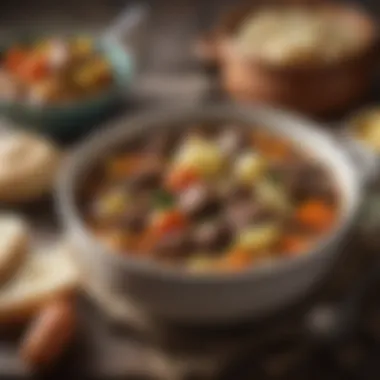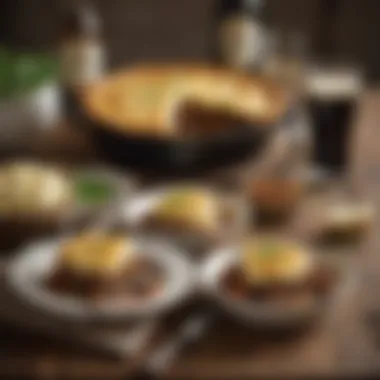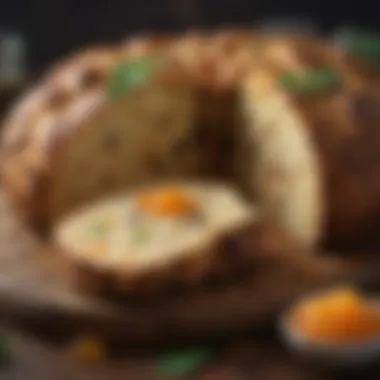St. Patrick's Dinner Recipes: Celebrate with Authentic Flavors


Intro
As the calendar edges towards mid-March, something magical begins to stir in the hearts of many. The scent of hearty stews, the warm embrace of fluffy soda bread, and the clinking of pint glasses herald the arrival of St. Patrick's Day. It's a time to not only don emerald green attire but also to bring the spirit of Ireland right into our kitchens. The culinary traditions of the Irish are as rich and varied as the vibrant landscapes of the Emerald Isle itself. Whether you’re gathering with friends, family, or indulging in personal reflection over a fine meal, preparing an authentic St. Patrick's dinner serves as a delightful tapestry weaved from history, culture, and flavor.
The meals we’ll explore here go beyond mere sustenance; they're a celebration of cultural heritage, a homage to generations who have celebrated with these very recipes. From the comforting simplicity of Colcannon—a mix of mashed potatoes and kale—to the robust flavors of beef and Guinness stew, each dish tells a story of its own.
Imagine the sound of laughter echoing through a cozy kitchen as you chop fresh vegetables, stirring fragrant herbs into sizzling pots. As you follow along with these recipes, you’ll discover not just a method but a connection to Irish customs, passed down through ages. So, grab your apron and get ready to uncover the treasures that lie within the heart of St. Patrick's dinner recipes, where creativity meets tradition.
Intro to St. Patrick's Day Celebrations
St. Patrick's Day is not just a day for parades and wearing green; it’s a vibrant celebration of Irish culture and identity. This festivity marks the feast day of St. Patrick, the patron saint of Ireland, who is credited with bringing Christianity to the region. Observed on March 17, St. Patrick's Day has evolved into a global phenomenon, where connections to heritage and community take center stage. This article aims to give you a comprehensive look at the culinary aspect of the celebrations, making it a noteworthy topic for food lovers and those keen on cultural exploration.
Emphasizing the importance of celebrating Irish heritage through cooking invites everyone to engage not just in traditions, but in flavors and stories that accompany them. From the hearty comfort of Irish beef stew to the sweet, dense slices of soda bread, preparing these dishes enables a connection to the past and a celebration of the present. This is where the art of cooking shines—transforming simple ingredients into meals that stir emotions and evoke memories.
The Significance of St. Patrick's Day
St. Patrick’s Day holds various meanings to different people. For many, it’s a day to feel a sense of pride in Irish ancestry, while for others, it represents a time for social gatherings and joy. The day serves as a reminder of the resilience and creativity within Irish culture, which has permeated through centuries and around the globe. Food is a significant part of this day, acting not merely as sustenance but as a medium for celebrating collective memories and history.
Importantly, each dish has its own story. Like the folklore that surrounds them, these recipes, such as Colcannon and Irish stew, developed over generations, and understanding their origins can deepen your appreciation. It’s not just about eating; it’s about experiencing a piece of culture, family, and the stories that bind us together. Cooking and sharing a St. Patrick’s Day meal becomes a form of honoring those who came before—a truthful homage to the culinary practices that shaped Irish identity.
Historical Context of Irish Cuisine
Irish cuisine is a tapestry woven from the land's bounty and the historical experiences of its people. For centuries, it has been influenced by invasions, migration, and economic changes that shaped the country’s farming practices and food availability. Historical events, especially the Great Famine in the 19th century, transformed the Irish diet profoundly, pushing people to adapt and innovate in their cooking pursuits.
The staple ingredients of Ireland—potatoes, cabbage, and lamb—have roots that reflect the resilience and practicality of the people. Potatoes, introduced in the late 16th century, became a cornerstone of the Irish diet. When times got tough, these hearty tubers provided much-needed sustenance. They are further embodied in dishes like Champ, a comforting potato mash with scallions, echoing the simple yet satisfying cuisine of Ireland.
Unpacking the layers of how Irish cuisine has evolved gives insight into not only what is served on the table but also how those meals capture the soul of the nation. Try to imagine the cold, wet climate of Ireland influencing meals that are rich and hearty, designed to fill bellies and warm hearts. The food, intertwined with stories of struggle and perseverance, speaks volumes about the Irish spirit.
St. Patrick's Day, then, becomes a perfect occasion to delve deeply into these flavors, enjoying dishes that have stood the test of time while also making room for modern interpretations. Celebrating these traditions through cooking not only honors the past but also opens a door to understanding the cultural fabric of Ireland today.
"Food is a central ingredient in our understanding of culture."
Embrace the flavors, learn the stories, and celebrate the connections they foster among communities, near and far.
Core Ingredients for St. Patrick's Dinner
Crafting an authentic St. Patrick's dinner hinges on the mastery of essential ingredients that define Irish culinary art. These core ingredients reflect not just the flavors but carry a history that ties back to the land and its traditions. Understanding their significance helps in creating a meal that's not only tasty but also rich in heritage. Each ingredient contributes to the overall experience, whether it’s the earthy tones, comforting textures, or vibrant colors that they bring to the table. Incorporating these elements into your cooking is about more than just following a recipe; it’s about honoring the cultural importance behind them.
Potatoes: The Heart of Irish Cooking
When one thinks of Irish cuisine, it's hard not to envision potatoes. Often dubbed the heart of Irish cooking, these humble tubers are both versatile and nutrient-rich. From creamy mashed potatoes to crispy roasted varieties, their adaptability allows them to fit seamlessly into various dishes.


Historically, potatoes were introduced to Ireland in the late 16th century and quickly became a staple food. They provided sustenance during the Great Famine, a time that profoundly shaped the Irish identity. Today, potatoes are celebrated in dishes like champ, potato farls, and colcannon. A simple yet powerful way to respect this ingredient is cooking it with skin on, which not only boosts flavor but retains valuable nutrients. Adding butter, cream, and even a sprinkle of chives can elevate these dishes, bringing comfort to any table.
Lamb: A Traditional Favorite
Lamb holds a cherished place in Irish hearts and kitchens, often served during festive occasions, including St. Patrick's Day. Its rich, succulent flavor pairs beautifully with root vegetables and herbs commonly found in Irish cooking. Traditionally, Irish lamb is typically grass-fed, lending a distinctive taste that stands out in its dishes.
From hearty Irish lamb stew, simmered low and slow for flavors to meld, to roasted lamb with a crust of garlic and rosemary, the preparation can vary widely. Cooking lamb brings about a warm, inviting aroma that gathers families around the table. Whether you prefer a simple roast or a more intricate dish, choosing a quality cut is crucial. One can also opt for lamb shanks or shoulder for stews, making sure that each bite is as tender as can be.
Root Vegetables and Greens
Root vegetables like carrots, parsnips, and turnips are staples in the Irish pantry, often accompanying main dishes or standing alone in side preparations. They provide natural sweetness and a depth of flavor that truly completes a St. Patrick's Day spread. Carrots and parsnips, roasted together with potatoes, can be a delightful centerpiece. On the other hand, greens such as cabbage and kale also play an integral role. From colcannon—mashed potatoes combined with greens—to cabbage boiled with bacon, the combination of these earthy flavors is nothing short of magical.
Overall, the core ingredients encapsulate the soul of St. Patrick's Day celebrations. Understanding the importance of potatoes, lamb, and a variety of root vegetables not only enlightens the cooking process but also deepens the appreciation for their cultural roots. This connection between food and culture is precisely what makes each meal not merely sustenance but a celebration in itself.
Classic St. Patrick's Day Recipes
St. Patrick's Day is more than just a day to wear green and celebrate in parades; it's about honoring the rich cultural heritage of Ireland through food. The Classic St. Patrick's Day Recipes section serves as the heart and soul of this culinary exploration. These recipes are steeped in tradition and reflect the history of Irish cuisine, utilizing staple ingredients that not only nourish but bring families and friends together. By embracing these classic dishes, you not only enjoy flavors that are deeply satisfying but also partake in a cultural experience that transcends generations. The following recipes offer a glimpse into meals that have been enjoyed for centuries, while also allowing room for modern adaptations.
Irish Beef Stew
Ingredients and Preparation Techniques
Irish Beef Stew is the comforting dish synonymous with warmth and heartiness, making it a staple for St. Patrick's Day. This stew usually combines beef, carrots, onions, and, of course, potatoes. The preparation traditionally calls for browning the beef first to seal in those robust flavors, then simmering everything together in a rich broth often made with beer, which adds a certain depth to the taste. One of the defining characteristics of this stew is the use of simple yet hearty ingredients. This straightforwardness allows the natural flavors of each component to shine through without unnecessary fuss.
The preparation method of slow-cooking gives the meat time to become tender. This contribution helps create a dish that feels fulfilling. While preparing this stew, it’s essential to keep an eye on the timing; overcooking can lead to mushy vegetables, which detracts from their fresh taste.
"Cooking doesn't have to be complex; it's about letting good ingredients sing."
Garnishes and Serving Suggestions
When it comes to garnishing and serving your Irish Beef Stew, fresh herbs like parsley or thyme work wonders. They lend a vibrant touch that makes the dish appealing and fresh to the eyes. Garnishing isn’t just for aesthetics; it can enhance flavor profiles, making each mouthful even more enjoyable. Serving the stew with a side of Irish soda bread not only rounds out the meal but also serves as the perfect vehicle for scooping up the rich broth.
The unique feature about these garnishes and serves is simplicity. There’s a beauty in their minimalism that aligns with the spirit of traditional Irish cooking. Opting for straightforward accompaniments can be more beneficial than extravagant options, allowing the stew to take center stage, just as it deserves.
Colcannon: A Soulful Side Dish
Variations and Dietary Options
Colcannon is a quintessential Irish dish, primarily made of mashed potatoes combined with cabbage or kale. What makes Colcannon so special is its adaptability; you can easily switch out ingredients to cater to various dietary requirements. For instance, substituting regular potatoes with sweet potatoes gives this side a different character, and using cauliflower can make it a great low-carb option. It’s an excellent showcase of how traditional recipes can evolve while maintaining their nourishing essence.
This dish has an innate comfort factor; it’s great for cooler weather, evoking memories of cozy dinners. The flexibility Colcannon offers means it can remain relevant in any household, appealing to younger generations while honoring its origins.


Irish Soda Bread
Traditional Methods vs. Modern Takes
Irish Soda Bread bears witness to the ingenuity of Irish baking, using baking soda as a leavening agent rather than yeast. Traditionally, buttermilk plays a crucial role in this recipe, reacting with the soda to create a light yet dense bread. The method itself is rather easy, making it accessible even to novice bakers. In modern times, people experiment by adding ingredients like seeds or dried fruits to give the bread a twist, which showcases creativity and personal tastes.
The beauty of exploring both traditional methods and modern adaptations lies in the spectrum of textures and flavors you can achieve. While a classic, plain Irish Soda Bread is a celebration of its roots, adding your spin can make it a centerpiece of culinary exploration. However, care should be taken that these adaptations do not overshadow the bread's essence, ensuring it remains true to its Irish heart.
In summary, Classic St. Patrick's Day Recipes blend time-honored tradition with the expansive creativity of the present day. Each dish tells a story, inviting both personal interpretation and reverence for the past.
Contemporary Interpretations of Irish Recipes
Contemporary interpretations of Irish recipes have become increasingly popular among food lovers. This shift reflects a growing acceptance of innovation while maintaining respect for traditional elements. These modern takes often match the evolving tastes and preferences of a diverse audience. As culinary experimentation broadens, chefs and home cooks alike are inviting a mix of cultural influences into their kitchens, enriching the dining experience.
Reimagining classic dishes creates opportunities to cater to various dietary needs and preferences. For instance, classic ingredients can be substituted to create exciting new versions of iconic meals. This subsection delves into twists on traditional dishes and highlights the significance of such innovations in enhancing our appreciation of Irish culinary heritage.
Twists on Traditional Dishes
Fusion Cuisine Influences
Fusion cuisine is a culinary approach evident in many aspects of contemporary interpretations of Irish recipes. It brings together different cooking styles and flavors from diverse cultures, resulting in unique offerings that captivate the palate. In the context of Irish meals, this often means combining classic Irish ingredients with spices, techniques, or ideas from far-flung culinary traditions.
One notable characteristic of fusion cuisine is its versatility. For instance, Irish lamb stew could receive a surprising twist when integrated with Asian spices, creating a new depth of flavor that challenges our traditional notions. Another example includes incorporating ingredients like quinoa or black beans into traditional colcannon. This approach not only garners interest but also builds bridges between cultures, thus promoting a sense of community.
However, the fusion aspect doesn't come without its considerations. Balancing flavors while ensuring the dish remains a true reflection of its Irish roots can be tricky. If the essence of the traditional recipe gets lost amid overpowering new influences, it might alienate purists who cherish the history behind every meal. In essence, culinary freedom in fusion dishes must be approached judiciously, keeping both innovation and tradition in mind.
Healthy Variations
Alternative Ingredients for Modern Diets
Adapting Irish recipes to align with modern dietary choices has gained traction in recent years. This is particularly relevant as more individuals gravitate toward healthier eating or have specific dietary restrictions. Exploring alternative ingredients for modern diets not only acknowledges these trends but also invites creativity in the kitchen.
A key characteristic of these healthy variations is their reliance on fresh, wholesome ingredients. For instance, instead of using a heavy cream in traditional chowder, a cook might opt for a vibrant vegetable broth and use blended cauliflower for creaminess. This swap not only cuts calories but also enhances the nutritional profile of the dish, making it more suitable for a health-conscious audience. Similarly, many are experimenting with gluten-free, dairy-free, or plant-based substitutes, ensuring that everyone can enjoy a festive meal without compromise.
The unique feature of incorporating alternative ingredients is how it drives the evolution of classic recipes while providing options for those with specific lifestyle choices. The benefits are clear, as these twists make traditional Irish food accessible and inviting to a broader audience. On the flip side, there is a risk of alienating some diners who appreciate the authenticity of classic recipes. Each adaptation carries the weight of expectations—while flexibility is essential in the culinary world, it's equally vital to honor the original flavors that make Irish cuisine so beloved.
"Food is not just sustenance; it is a connection to history, culture, and community."
Hosting a St. Patrick's Day Dinner
When it comes to celebrating St. Patrick's Day, hosting a dinner is not just about putting food on the table. It's all about creating an experience that resonates with the traditions and flavors of Irish culture. The essence of this celebration can be tasted and felt through the meals we prepare. A thoughtfully planned St. Patrick's dinner cultivates a sense of community. Friends and family gather to share stories, laughter, and of course, delicious food.


First, there's the charm of home-cooked meals, which often links back to family heritage. Setting the atmosphere with intentional details boosts the whole event. Every element—from the choice of recipes, to the decorations, to the beverages—contributes to an immersive, enjoyable evening. This dinner is more than just sustenance; it’s a chance to explore, enjoy, and deepen a connection with Irish roots.
Creating an Irish-Inspired Ambiance
Creating a welcoming ambiance is crucial to enhancing the experience of a St. Patrick's Day dinner. The atmosphere sets the tone for the gathering. Simple touches can transport guests to the heart of Ireland. Think about incorporating traditional Irish attire, lively music, and perhaps some folklore. These elements breathe life into the setting and evoke a sense of place.
Decor and Table Settings
When it comes to decor and table settings, opting for natural materials and earthy tones can weave a vivid tapestry of Ireland's landscapes right into your dining room. Using burlap table runners paired with wooden serving boards brings an organic feel. Sprinkling green clovers or white blooms as centerpieces honors the theme beautifully.
- Key Characteristic: Authenticity. Authentic items create a genuine vibe. Choosing handmade ceramics or vintage glassware reflects the charm of rural Irish homes.
- Beneficial Choice: It cultivates an immersive experience that is not just visual but tactile and olfactory as well.
- Unique Feature: You might also consider using candles. They not only provide warmth but also initiate conversation around flickering flames, reminiscent of the coziness found in pubs and homes across the Emerald Isle.
However, there can be downsides to an overly complicated setup. Too many decorations might overwhelm the senses rather than focusing on the meal itself. Keeping it simple and thoughtful usually yields better results.
Pairing Drinks with Dinner
The art of pairing drinks with a St. Patrick's dinner is equally significant. It serves to elevate the flavors of the meal, while also paying homage to the rich brewing traditions of Ireland. Choosing the right beverages can create a harmonious balance with the food, enhancing flavors and creating new experiences.
Traditional and Modern Beverage Options
When selecting drink options, think about both traditional and modern interpretations that complement your dinner. Perhaps you could serve a classic Irish stout like Guinness, known for its bold flavors complemented by rich, hearty dishes.
- Key Characteristic: Versatility. Both traditional stouts and modern craft beers work well, offering something for everyone.
- Beneficial Choice: It allows for an exploration of tastes that reflect the evolution of Irish beverages over time.
- Unique Feature: You could also explore modern cocktails inspired by Irish ingredients—think whiskey sours made with locally-sourced apples.
But be mindful; not pairing the right drinks can dilute the flavors of the carefully prepared dishes. Ensuring a thoughtful balance in choice makes all the difference in the overall experience.
End: Embracing Culinary Heritage
As we wrap up this culinary exploration, it becomes clear just how significant food is in shaping and preserving cultural identity. In the context of St. Patrick's Day, this celebration of Irish cuisine deeply intertwines with the historical and social fabric of the Irish people. Enjoying traditional dishes isn't merely about sustenance; it’s an act of honoring a lineage that stretches back generations.
Food is a vessel for storytelling and connection. Each dish served during a St. Patrick's dinner tells a tale of heritage, family traditions, and regional flavors. For example, Irish Beef Stew not only fills the belly but also invites you to glimpse the Irish way of life—one that has endured hardship and rejoiced in community gatherings. The heft and warmth of this stew can transport one to a cozy kitchen in a rural village, where smells wafting from the pot form an unspoken bond between generations.
The Role of Food in Cultural Identity
Food acts as more than nutritional sustenance; it’s an essential part of cultural identity. For the Irish, dishes like Colcannon and Irish Soda Bread are not simply recipes; they’re a testament to their resilience and ingenuity. Traditionally made with locally sourced ingredients, these dishes reflect the flavors of the land, embodying the very essence of Irish culture.
Eating these meals during St. Patrick's Day is akin to participating in a communal rite, one that celebrates both heritage and unity.
The experience of sharing a meal—whether it’s with family at home or friends gathered around the dinner table—is a celebration of connection. It reminds us that despite geographical distances or generational gaps, food is a common language that transcends barriers.
"To cook is to love, and to partake in a meal is to embrace history."
Here are a few elements to consider when reflecting on the role of food in cultural identity:
- Tradition: Every dish carries its history, providing insights into a community’s past and its evolving practices.
- Community: Recipes are often shared among generations, fostering family bonds and cultural pride.
- Identity: In today’s world, food remains a powerful expression of who we are, highlighting diversity and heritage in every bite.
The benefit of embracing culinary heritage lies in the deeper understanding it offers of one’s identity and the identities of others. As we enjoy a dish, we aren't just savouring the flavors; we are also participating in a rich tapestry that unites us through shared experiences. This St. Patrick’s Day, as you gather around the table, take a moment to appreciate the significance behind each dish. Let it be a celebration not just of food, but of the traditions and stories we carry with us.







